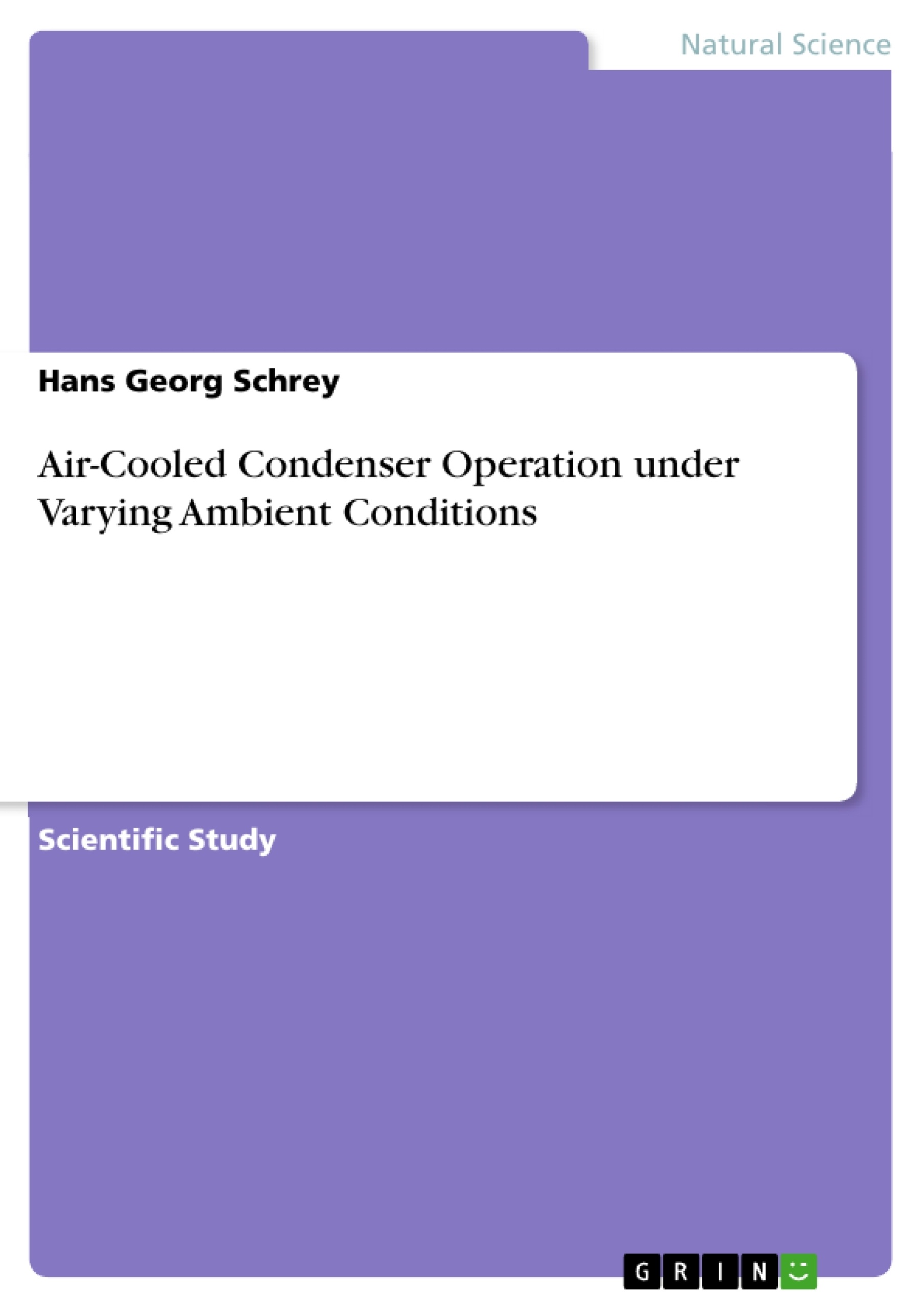The objective of this report is to make up for the following deficiencies at least on a general level – while still using first principles.
Air-cooled condensers are widely used at the cold end of thermal power cycles. With this equipment cooling water required in wet cooled power plants may be saved on a large scale. To operate fans which convey dry cooling air to the condenser modules electric power is required which reduces overall power plant effectiveness. Consequently, pumping power consumption should be as small as possible. During operation it is therefore common to reduce fan power consumption by switching down or off fans of individual modules or, in some case complete ACC streets if ambient conditions and operation parameters are promising.
Performance guarantees are normally specified with all equipment in full action. Only primary variable variations such as ambient temperature, ambient air pressure or total steam flow rate for a reduced range at fan full speed are part of the performance guarantee. Therefore, effects of fan switch or high cross-wind levels remain open issues.
Table of Contents
- 1 Introduction
- 2 ACC Layout
- 3 General ACC Model
- 4 ACC Steam Duct
- 5 Constant Exhaust Pressure
- 6 Variation of Fan Speed
- 7 Cross Wind
- 8 Cross-Wind – Pressure Drop
- 9 Cross-wind – Recirculation
- 10 Summary
Objectives and Key Themes
The objective of this report is to improve the understanding of air-cooled condenser (ACC) operation under varying conditions, particularly part-load operation and cross-wind effects, using first principles. This addresses deficiencies in standard acceptance test procedures which typically only cover full-speed operation within a limited range of primary variable variations.
- Performance of air-cooled condensers under varying operational conditions (fan speed, part-load operation).
- Impact of cross-wind on ACC performance (pressure drop, recirculation).
- Development of generalized models for ACC performance prediction based on first principles.
- Comparison of forced draft and induced draft ACC configurations.
- Practical application of developed models for design and operational considerations.
Chapter Summaries
1 Introduction: This chapter introduces the increasing use of air-cooled condensers (ACCs) in thermal power plants due to environmental concerns and water conservation. It highlights the historical cost disparities between ACCs and wet cooling systems and discusses advancements in fin tube performance, steam flow configuration, and fan design that have led to increased ACC adoption. The chapter emphasizes the importance of understanding ACC performance under varying operational conditions beyond the design point, particularly part-load operation (fan or ACC street switch-off) and the effects of cross-wind, which are not typically covered by performance guarantees. The need for a generalized approach, based on first principles, to analyze these operational deficiencies is established.
2 ACC Layout: This chapter describes the traditional two-pass ACC layout with forced draft fans and the newer three-pass design with induced draft fans. The traditional design uses an A-frame arrangement of condenser and dephlegmator bundles, while the three-pass design incorporates a shortened tube length to reduce pressure drop and improve manufacturability and on-site assembly. The chapter contrasts the advantages and disadvantages of both designs regarding cross-wind sensitivity and air recirculation. Despite their differences, both types of ACC can be analyzed by first-principle considerations, eliminating the need for specific acceptance standards for each arrangement.
3 General ACC Model: This chapter presents a simplified model for analyzing ACC performance. It defines a "module" as a combination of heat transfer bundles and a fan, assuming identical tube bundle geometry across all modules. The model simplifies the thermal analysis by treating condenser and dephlegmator modules similarly. It uses steam-side and air-side parameters (temperature, pressure, flow rates) to describe the heat transfer process and incorporates the Antoine equation to relate steam temperature and pressure. The model focuses on the design point parameters to simplify calculations and introduces parameters like exchanger effectiveness and number of transfer units for heat duty estimation.
4 ACC Steam Duct: This chapter expands the ACC model to incorporate the steam duct and its influence on pressure drop. It calculates the module inlet conditions by accounting for pressure losses in the duct. The design pressure drop is discussed in relation to saturation pressure. The chapter describes a calculation procedure for creating performance charts, showing examples for constant heat duty and constant ambient temperature.
5 Constant Exhaust Pressure: This chapter refines the model to handle constant turbine exhaust pressure, which is a crucial operational constraint. This requires linearization of the Antoine equation and introduces several new parameter ratios. The chapter presents a three-step procedure to express exhaust pressure as a function of heat duty and ultimately develops an equation for calculating heat duty as a function of exhaust pressure. An example performance diagram for constant exhaust pressure is presented.
6 Variation of Fan Speed: This chapter assesses the impact of varying fan speeds on ACC performance. Using the model from previous chapters, it demonstrates the effect of different fan speeds (80% and 60%) on turbine exhaust pressure. The chapter emphasizes that because the Antoine equation was not linearized in the previous example, results are considered reliable even for significant fan part-load operation.
7 Cross Wind: This chapter introduces the detrimental effects of cross-wind on ACC performance, summarizing the key issues: maldistribution of flow and temperature profiles, additional air-side pressure drop, and hot air recirculation. It argues that accurately quantifying these effects using a general model is difficult due to the complexity of three-dimensional airflow patterns. The chapter outlines a simplified approach using average values and emphasizes the reliance on established procedures to assess the overall effects of crosswind.
8 Cross-Wind – Pressure Drop: This chapter focuses on quantifying the additional pressure drop caused by cross-wind. It introduces a "wind number" and a wind resistance factor to relate additional pressure drop to wind speed. A simplified model based on an elliptical fan performance curve is used to estimate the impact on air flow. The calculations differentiate between forced draft and induced draft configurations, adjusting parameters for the differing exit air velocities.
9 Cross-wind – Recirculation: This chapter addresses the phenomenon of hot air recirculation caused by cross-wind. It develops a model to estimate the recirculation rate based on deflection angles and airflow patterns. The model takes into account the geometry of the ACC, particularly the wind wall height and longitudinal length in the wind direction. The chapter distinguishes between forced and induced draft configurations, making necessary adjustments to parameters for each design. Finally, it calculates the effect of recirculation on mixed air inlet temperature and discusses the practical implications for ACC operation under windy conditions.
Keywords
Air-Cooled Condenser, ACC Design, ACC Operation, Cross-Wind Effect, Forced Draft, Induced Draft, Part-Load Operation, Performance Prediction, Heat Transfer, Pressure Drop, Air Recirculation, First Principles Model.
Air-Cooled Condenser (ACC) Performance Analysis: Frequently Asked Questions
What is the main objective of this report?
The report aims to improve the understanding of air-cooled condenser (ACC) operation under various conditions, especially part-load operation and cross-wind effects, using first principles. It addresses shortcomings in standard acceptance tests, which typically only cover full-speed operation under limited variable conditions.
What key themes are explored in this report?
Key themes include ACC performance under varying operational conditions (fan speed, part-load operation), the impact of cross-wind on ACC performance (pressure drop, recirculation), the development of generalized models for ACC performance prediction, a comparison of forced draft and induced draft ACC configurations, and the practical application of developed models for design and operational considerations.
What are the different chapters and their summaries?
The report is structured into ten chapters. Chapter 1 introduces the increasing use of ACCs and highlights the need for understanding performance beyond typical design points. Chapter 2 describes traditional and newer ACC layouts. Chapter 3 presents a simplified model for ACC performance analysis. Chapter 4 incorporates the steam duct's influence on pressure drop into the model. Chapter 5 refines the model for constant turbine exhaust pressure. Chapter 6 assesses the impact of varying fan speeds. Chapter 7 introduces the detrimental effects of cross-wind. Chapter 8 quantifies the additional pressure drop caused by cross-wind. Chapter 9 addresses hot air recirculation due to cross-wind. Chapter 10 provides a summary of the findings.
How does the report model ACC performance?
The report uses a simplified model that treats the condenser and dephlegmator modules similarly. It utilizes steam-side and air-side parameters (temperature, pressure, flow rates) and the Antoine equation to describe heat transfer. The model is refined across chapters to incorporate factors like steam duct pressure drop, constant exhaust pressure, and varying fan speeds. Simplified approaches are used for assessing cross-wind effects due to the complexity of three-dimensional airflow.
What are the key differences between forced draft and induced draft ACC configurations?
The report compares both configurations, particularly regarding their sensitivity to cross-wind and air recirculation. The differences in exit air velocities are considered when calculating the effects of cross-wind pressure drop and recirculation.
How does the report address the impact of cross-wind on ACC performance?
The report addresses cross-wind effects in several chapters, focusing on additional pressure drop and hot air recirculation. Simplified models using average values and parameters like "wind number" and wind resistance factor are used to estimate these effects. The models distinguish between forced and induced draft configurations.
What are the key parameters used in the ACC performance model?
Key parameters include steam-side and air-side temperatures and pressures, flow rates, exchanger effectiveness, number of transfer units, pressure drop in the steam duct, fan speed, wind speed, and parameters related to cross-wind effects (wind number, wind resistance factor, deflection angles).
What are the practical applications of the models developed in this report?
The developed models can be used for design and operational considerations of ACCs. They allow for a better understanding of ACC performance under various conditions, enabling more efficient operation and potentially improved design.
What are the keywords associated with this report?
Air-Cooled Condenser, ACC Design, ACC Operation, Cross-Wind Effect, Forced Draft, Induced Draft, Part-Load Operation, Performance Prediction, Heat Transfer, Pressure Drop, Air Recirculation, First Principles Model.
- Quote paper
- Hans Georg Schrey (Author), 2024, Air-Cooled Condenser Operation under Varying Ambient Conditions, Munich, GRIN Verlag, https://www.hausarbeiten.de/document/1450374



